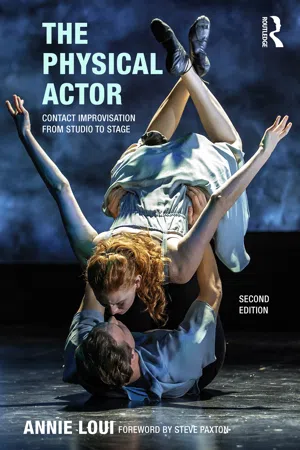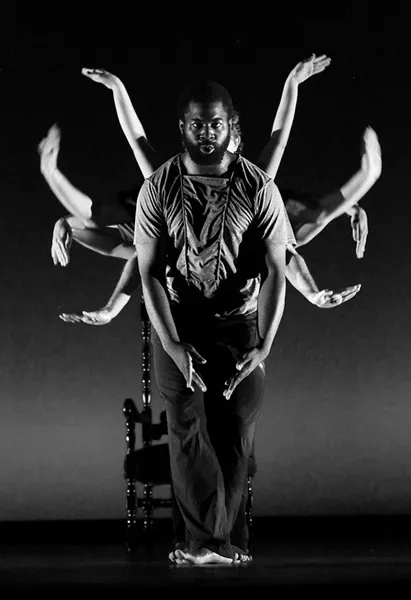
The Physical Actor
Contact Improvisation from Studio to Stage
Annie Loui
- 132 pagine
- English
- ePUB (disponibile sull'app)
- Disponibile su iOS e Android
The Physical Actor
Contact Improvisation from Studio to Stage
Annie Loui
Informazioni sul libro
The Physical Actor is a comprehensive book of exercises for actors. It is carefully designed for the development of a strong and flexible physical body able to move with ease through space and interact instinctively on-stage. Annie Loui draws on her training with Etienne Decroux, Carolyn Carlson, and Jerzy Grotowski to bring Contact Improvisation into the theatrical sphere. She explains how it can be used to develop alert and embodied listening skills in the actor, and how to apply it to working with texts on stage.
This book will guide the reader through a full course of movement skills, including:
-
- Partnering skills
-
- Spatial awareness for groups and individuals
-
- Fine motor control through mime
-
- Heightened co-ordination and sustained motion
New for this edition are additional partnering exercises, in-depth applications of contact improvisation to monologues and scenes, and a chapter on devising physical theatre performances.
Domande frequenti
Informazioni
CHAPTER 1
Warm-up and alignment

Warm-up: what we do and how we approach it
- 1 Begin with a simple aerobic sequence for cardiovascular engagement. I often begin a warm-up with three minutes of concentrated aerobic dancing, or run the Mao sequence (a five-minute comprehensive series of calisthenic/martial arts movements developed by Chairman Mao’s advisors to the public health). Of primary importance here is getting an increased circulation of blood flow to facilitate muscular stretch in the subsequent floor exercises.
- 2 Stretch and strength exercises should both be covered. They are mutually beneficial—once flexibility is improved, the supporting muscular structure must be strengthened, particularly the lower back and abdomen. Stretches must be done in a way to facilitate improvement for even the most inflexible of actors: slow extended breath with movement is useful; basic yoga stretches are optimum.
- 3 Pay attention to proper alignment. This refers to alignment of the spine and shoulders, pelvis, knees, and feet and should be addressed within the warm-up exercises. Alexander technique, Pilates, Feldenkrais, to name a few, all address proper placement of the body over the feet to best facilitate easeful motion. In the course of the notated warm-up and the introduction of mime isolations (in Chapter 3), I touch on a few alignment exercises I have found useful.
- 4 Use repetition. I had a new student respectfully address me after two weeks of class saying that he wanted to do a new warm-up—he already knew our exercises. I told him that I thought Baryshnikov probably already knew how to plié, but I suspect that he still did it every day. A daily warm-up is precisely that—a series of exercises repeated for the cumulative beneficial results. Repetition with small variations is useful in developing stretch, strength, and control. The sequence should basically remain consistent with small variations to keep the practitioner mentally alert.
- 5 Work intelligently. Of equal importance, and often overlooked, is the need for the actor to understand what he or she is working for in each exercise, and where to work from. For example, extending the torso out over the legs to stretch the hamstrings is a movement that needs to be initiated from the lower back. Whether you are perfect in execution today is immaterial—that you work intelligently and within your own physical limitations is imperative. “Burn” and sharp pain are not good—a long stretch initiated correctly, relaxing everything that is not needed in that particular movement, tends to be productive.
- 6 Incorporate imagery. This is one of the most valuable tools for the physical actor—and warm-up exercises can be engaged in most productively by the actor if specific images are connected to the movements. This can be done with the most literal of approaches (“imagine that you are a marionette with a string attached to the top of your head, elongating your spine, and pulling you up”). For the neophyte this will probably be effective as a first attempt to connect imagery with movement; however, I find subtle suggestions most useful (“the neck is long and the shoulders wide”). The neck may not be long, nor the shoulders wide, but the suggestion is now there—the actor should not use this as a command to make the neck long, but rather let the suggestion inform movement. I find that the actor’s body that is physically alert and fit will respond almost unconsciously to such suggestions with subtle and effective adjustments.
- 7 Practice respect. Aim to respect yourself as a serious training professional, respect the workspace, respect the person conducting the warm-up, and respect your colleagues; these are all modalities to be encouraged. Integrity of self within the work allows you to approach it in a relaxed and simultaneously energized state of being. The external discipline of engaging in rote exercise is useful, but only up to point. One engages consciously in the exercises, actively working on the specific task at hand. As an actor/practitioner you need to take responsibility for yourself and actively embrace the work, respecting yourself in the daily practice of your chosen profession.
Indice dei contenuti
- Cover
- Half Title
- Title Page
- Copyright Page
- Table of Contents
- Foreword
- Acknowledgments
- Endorsements
- Introduction
- 1 Warm-Up and Alignment
- 2 Space
- 3 Mime
- 4 Partnering
- 5 Contact Improvisation Practice and Scene Study
- 6 Contact into Realism
- 7 Devising
- Index